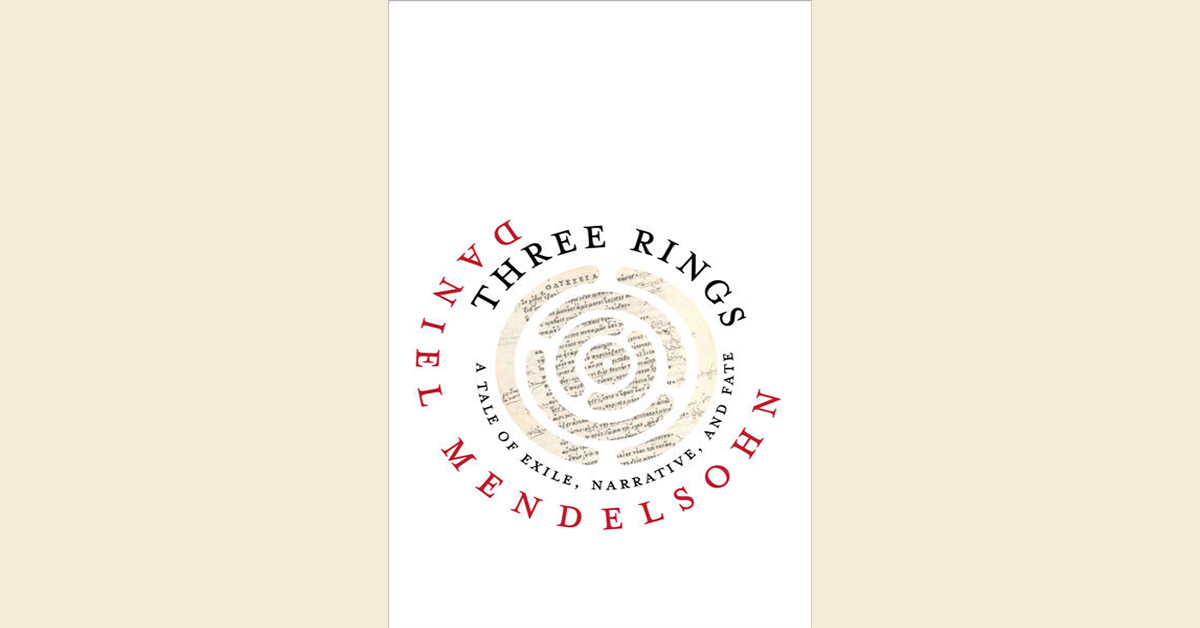Apr 19, 2021 By: yunews
Daniel Mendelsohn | University of Virginia Press | 2020
Reviewed by Rabbi Dr. Stu Halpern
Daniel Mendelsohn’s Three Rings: A Tale of Exile, Narrative, and Fate is a moving and learned meditation on narrative and exile. The author begins by recounting his struggles to recover from the psychologically draining process of writing about his family’s Holocaust history in The Lost: A Search for Six of Six Million. “Having listened to tales of violence and destruction for five years without being able to assimilate them emotionally… I was now, my friend surmised, having a delayed reaction,” stifled creatively and emotionally. As a means of recovery, Mendelsohn took on a project “whose fantastical characters and settings and intricate construction would beguile and mistract my still-bruised mind.” The result, An Odyssey: A Father, a Son, and an Epic, utilizes a Homeric ring structure, interweaving Mendelsohn’s teaching a seminar on the Odyssey (with his father as an auditor) within an analysis of the ancient classic itself. With a tone balancing between that of a journal and literary criticism, Three Rings utilizes a similar complex structure. One page offers the academic history of “ring composition” (a Dutch scholar named W. A. A. Van Otterlo published numerous studies on the subject), another discusses Aristotle’s Poetics, while another revisits the author's aforementioned struggles composing the earlier works. At roughly the start of every chapter, the motif of a stranger arriving in an unknown city reappears (“Who is he? He could be anyone in the past half century: A Syrian, a Bosnian, a Kurd, an Angolan, a Ugandan. A few decades before that he would likely have been a Jew”). Utilizing this conceit, Mendelsohn introduces the reader to the writing and wanderings of three authors whose seminal works were impacted by Homer’s—Erich Auerbach, François Fénélon, and W. G. Sebald. Auerbach, a German literary scholar and Jewish refugee, authored the renowned comparative literature volume Mimesis: The Representation of Reality in Western Literature during the 1940s. Its first chapter, “Odysseus’s Scar,” compares Homer’s work to storytelling in the Bible, with a particular focus on the notoriously opaque Binding of Isaac in the book of Genesis. As Mendelsohn writes, “... Auerbach finds the narrative instructability in the text of Genesis persuasively realistic. Just as we do not in fact know everything about the events and people encountered in our lives—certainly not the way in which the ring composition in Book 19 of the Odyssey allows us to know them—so too with the biblical narrative, which grants us only partial vision… and, because of its fragmentary nature, its imperfection, feels real.” François Fénélon, a French priest, centuries earlier, in 1699, composed a series of ethically instructive tales based on Homer’s Odyssey, which proved both immensely popular (selling more copies for 75 years after its publication than any work other than the Bible) and yet sealed his fall from grace in Versailles due to its not-too-thinly veiled criticisms of Louis XIV, whose grandson Fénélon had been tutoring. Winfried Georg Sebald, a German born after WWII, authored novels utilizing the ring structure as well. “But,” as Mendelsohn writes, “unlike the narrative rings, circles, digressions, and wandering we find in Homer, which seem designed to both illuminate and to enact a hidden unity in things, the ones we find in Sebald [in works like The Rings of Saturn], seem designed to confuse, entangling his characters in meanderings from which they cannot extricate themselves.” Readers interested in the theme of exile, the intellectual history of literature, and the reception history of Homer will particularly enjoy Three Rings. By way of background to this volume, and for a more popularly aimed work, Mendelsohn’s An Odyssey is highly recommended. To read more Straus Center book reviews, click here. You can learn more about the Straus Center and sign up for our newsletter here. Be sure to also like us on Facebook, follow us on Twitter and Instagram and connect with us on LinkedIn.

